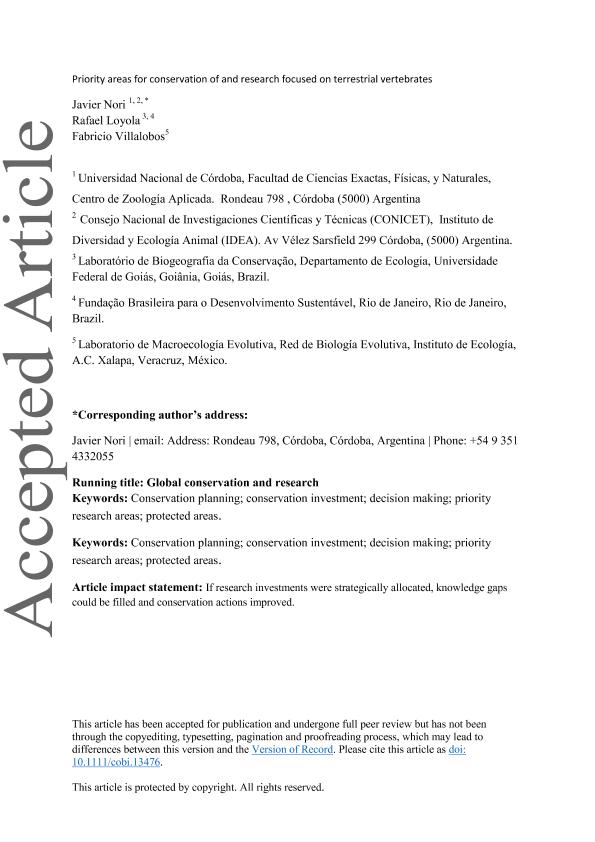Mostrar el registro sencillo del ítem
dc.contributor.author
Nori, Javier

dc.contributor.author
Loyola, Rafael

dc.contributor.author
Villalobos, Fabricio
dc.date.available
2021-09-23T18:15:43Z
dc.date.issued
2020-10-03
dc.identifier.citation
Nori, Javier; Loyola, Rafael; Villalobos, Fabricio; Priority areas for conservation of and research focused on terrestrial vertebrates; Wiley Blackwell Publishing, Inc; Conservation Biology; 34; 5; 3-10-2020; 1281-1291
dc.identifier.issn
0888-8892
dc.identifier.uri
http://hdl.handle.net/11336/141401
dc.description.abstract
Effective conservation policies require comprehensive knowledge of biodiversity. However, knowledge shortfalls still remain, hindering possibilities to improve decision making and built such policies. During the last 2 decades, conservationists have made great efforts to allocate resources as efficiently as possible but have rarely considered the idea that if research investments are also strategically allocated, it would likely fill knowledge gaps while simultaneously improving conservation actions. Therefore, prioritizing areas where both conservation and research actions could be conducted becomes a critical endeavor that can further maximize return on investment. We used Zonation, a conservation planning tool and geographical distributions of amphibians, birds, mammals, and reptiles to suggest and compare priority areas for conservation and research of terrestrial vertebrates worldwide. We also evaluated the degree of human disturbance in both types of priority areas by describing the value of the human footprint index within such areas. The spatial concordance between priority conservation and research areas was low: 0.36% of the world's land area. In these areas, we found it would be possible to protect almost half of the currently threatened species and to gather information on nearly 42% of data-deficient (DD) species. We also found that 6199 protected areas worldwide are located in such places, although only 35% of them have strict conservation purposes. Areas of consensus between conservation and research areas represent an opportunity for simultaneously conserving and acquiring knowledge of threatened and DD species of vertebrates. Although the picture is not the most encouraging, joint conservation and research efforts are possible and should be fostered to save vertebrate species from our own ignorance and extinction.
dc.format
application/pdf
dc.language.iso
eng
dc.publisher
Wiley Blackwell Publishing, Inc

dc.rights
info:eu-repo/semantics/openAccess
dc.rights.uri
https://creativecommons.org/licenses/by-nc-sa/2.5/ar/
dc.subject
CONSERVATION INVESTMENT
dc.subject
CONSERVATION PLANNING
dc.subject
DECISION MAKING
dc.subject
INVERSIÓN EN LA CONSERVACIÓN
dc.subject
PLANEACIÓN DE LA CONSERVACIÓN
dc.subject
PRIORITY RESEARCH AREAS
dc.subject
PROTECTED AREAS
dc.subject
TOMA DE DECISIONES
dc.subject
ÁREAS PRIORITARIAS PARA LA INVESTIGACIÓN
dc.subject
ÁREAS PROTEGIDAS
dc.subject.classification
Conservación de la Biodiversidad

dc.subject.classification
Ciencias Biológicas

dc.subject.classification
CIENCIAS NATURALES Y EXACTAS

dc.title
Priority areas for conservation of and research focused on terrestrial vertebrates
dc.type
info:eu-repo/semantics/article
dc.type
info:ar-repo/semantics/artículo
dc.type
info:eu-repo/semantics/publishedVersion
dc.date.updated
2021-09-06T15:48:40Z
dc.identifier.eissn
1523-1739
dc.journal.volume
34
dc.journal.number
5
dc.journal.pagination
1281-1291
dc.journal.pais
Reino Unido

dc.journal.ciudad
Londres
dc.description.fil
Fil: Nori, Javier. Consejo Nacional de Investigaciones Científicas y Técnicas. Centro Científico Tecnológico Conicet - Córdoba. Instituto de Diversidad y Ecología Animal. Universidad Nacional de Córdoba. Facultad de Ciencias Exactas Físicas y Naturales. Instituto de Diversidad y Ecología Animal; Argentina
dc.description.fil
Fil: Loyola, Rafael. Universidade Federal de Goiás; Brasil
dc.description.fil
Fil: Villalobos, Fabricio. Instituto de Ecología, A. C. Red de Biología Evolutiva. Laboratorio de Macroecología Evolutiva; México
dc.journal.title
Conservation Biology

dc.relation.alternativeid
info:eu-repo/semantics/altIdentifier/url/https://onlinelibrary.wiley.com/doi/abs/10.1111/cobi.13476
dc.relation.alternativeid
info:eu-repo/semantics/altIdentifier/doi/http://dx.doi.org/10.1111/cobi.13476
Archivos asociados
